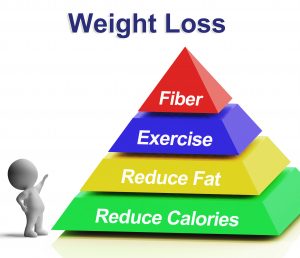Maximize Fat Loss
What dieters should focus on is fat loss and not weight loss. Ultimately, maximizing fat loss is all about calories in versus calories out and a total deficit of 3500 calories to lose 1 pound of body weight[1]. This fact is true, but how much less should you eat to lose fat and how do you prevent muscle loss and maximize fat loss?
This question is one of the most important parts of weight loss and losing muscle while dieting is the hardest thing to prevent. There are lots pros and cons of each size of calorie deficit, and you may want to vary your debt depending on your goals.
Folks in the low-carb community will dispute the law of caloric balance. Protein is not magic macronutrient that automatically causes weight loss, but is does take more calories to utilize as energy. If you want to believe that manipulation the percentage of macronutrients magically speeds up your metabolism and make the laws of physics no longer matter? Do not read any further, because this article will only go over facts and not this fiction.
Calories are what matters to weight loss because quality affects quantity. A low-quality diet is often one that is higher in calories bust especially processed calories. Any diet high in calories will lead to weight gain if you an excess in calories over your demand. A deficit will result in loss even one based on junk food[2]. If you have been through the checkout line at a grocery store, you may have seen the Twinkie Diet Book. It has been proven to work. This being said it is much harder to stay on this diet because it will increase hunger with all the insulin spikes.
Different Size of Deficits And Fat Loss
Large and small calorie deficits can be appropriate in some situations but can be unsafe in other. I have heard in the past that fast weight loss will result in weight regained, but there is not much evidence to support this. Even though this is not true, I think it is important to individualize the deficit and lose weight relatively slow so that you learn to change your lifestyle.
I recommend that you take a 15-25% deficit calculated based upon your total caloric requirement. I rarely support more than 25%, but it can be appropriate with the assistance of a medical provider and dietician. It is very hard to keep the weight off once you lose the fat if you do not add exercise, but diet is more important than exercise to lose it.
Think of your caloric deficit as a continuum in balance. The smaller the deficits, the longer it will take to reach your goal but also the less difficult it is to maintain. Many variables affect the rate and amount of fat that you lose.
Variables Effecting Fat Loss:
- Your Overall Metabolic Rate. If you have a high metabolism, you will require more calories and therefore the percentage deficit will be a larger number of calories and thus you will lose the weight faster. The change in metabolic rate is probably not a huge difference, but every calorie counts. There is evidence that we adapt to weight loss to try and lower our metabolism as an attempt to regain the weight[3],[4]. Age, sex, obesity, stress, and inflammation reduced metabolism rate[5].
- You Total Muscle Mass. Total muscle mass plays into your metabolic rate, but it is not entirely the same. Muscle is what burns calories for the most part, so if you have more, you will burn more calories.
-
Type of Exercise You Choose. Fat burning requires aerobic processes, and you burn a higher percentage of fat if you can talk when you are exercising. Sure, you will burn more fat running, but you also burn more sugar. It is the ratio that is the key. Long distance runners will metabolize muscle during the race to make glucose. You do not want to do this when you are trying to lose fat. There is plenty of research to indicate that interval training is superior for fat loss[6],[7].
- Support Network and Follow-ups. One study looked at very low-calorie diets, and help from behavioral health and medical follow-up and found that patients are more successful in losing and keeping fat off with proper support and follow-up with a medical provider[8].
- The Size of Your Calorie Deficit. The larger the calorie deficit, the faster you will lose fat to a certain point. One thing is sure is that very large calorie deficits over 800 calories do not increase weight loss over low-calorie deficits according to one study[9].
- Staying Power. Your ability to maintain the diet and remain committed to you path to health will ultimately effect the rate and amount of weight loss you attain. If you yo-yo or diet intermittently, you ill be less successful. For some, losing the weight fast will allow them to stick to the diet and others, learning the routine to maintain may not happen so they may gain it back. To, others, slow is easier. At least one study shows evidence to suggest that a greater initial weight loss as the first step of a weight management program may result in improved sustained weight maintenance[10]. If you think about, this only makes sense because it will be encouraging to see results.
Larger calorie deficits, which I define as over 25% of your total caloric requirement, result in faster rate of fat loss, provides greater immediate gratification which can encourage adherence and motivation, and reduces the chance you’ll eat too much. The weakness to a large deficit is that required to eat much less food, the deficit often much more self-control, makes it harder to get the vitamins and minerals, and diminishes learning of longer term habits to maintain the weight loss.
Smaller calorie deficit, which I define as under 25%, results in reduced number of lifestyle changes, are easier to maintain, has lower hunger levels, can lead to less muscle mass loss, and may increase adherence if the dieter is patient. The weakness to small deficits is weight loss is that slower weight loss. The lower deficit also means a little lapse is a huge problem, and you have to be more diligent at watching what you eat.
Deciding the Right Deficit Must Be Individualized:
Finding the right calorie balance is an art that must be individualized. I plan my deficit carefully at about 250-500 calories per day which is about 15-25% depending on what BMR calculation you use. A deficit that is perfect for one person may not work for another. Cutting calories too much often creates hunger and cravings, but small calorie gaps make weight loss too slow and may discourage the dieter. Play around with your calorie debt and find a balance or calories that work best for you.
Seven Recommendations or Keys to Maximize Fat Loss:
-
Maximize Your Muscle. Muscles are fat-burning power plants, so be sure to do enough resistance training to build and maintain them. Strength training not only builds muscle, it
- Add Weight Bearing Cardio Exercise. Cardio will burn fat. Try to start slowly and exercise so that you can talk while performing it. Interval training is great for weight loss.
- Get Enough Sleep. Sleep improves healing and reduces stress which will both increase the amount of fat you burn and reduce fat storage. In general, you burn more calories sleeping than being sedentary, for example, sleep versus watching TV.
- Stick to a Meal Schedule. If you avoid delays in meals, you will be less likely to crave foods and more likely to stick to your diet. If you are hungry, have a snack. That being said, the snack should probably not be potato chips.
- Drink Plenty of Water. Water Can fill you up, and dehydration can create hunger. Dehydrated people tend to be constipated. Water is also required to remove wastes from your body.
- Eat Whole Foods that Are Less Processed. Unprocessed foods tend to have more fiber and will keep you full longer.
- Stay Positive and Focus on Your Strengths. A positive attitude can go a long way to maintaining a good body image and maintaining motivation.
- Limit the Liquid Courage. High liquid calorie intake, whether it is from alcohol or soda, is directly associated with body weight and fat gain. This list of high-calorie drinks includes alcohol, soda, juice, and high-calorie coffee drinks energy drinks. Added problems with alcohol are that its consumption leads to poorer food choices due to the inhibition changes it causes.
- You cannot go wrong with vegetables.
How many fat vegetarians do you see that truly follow a vegetarian diet? If you can gain weight eating fresh vegetables, I will shake your hand. If you need to snack, snack on these. - Eat Enough Protein. Protein is filling. You should have at least 1 gram of protein for each Kg of body mass.












